 W
WAcorus calamus is a species of flowering plant, a tall wetland monocot of the family Acoraceae, in the genus Acorus. Although used in traditional medicine over centuries to treat digestive disorders and pain, there is no clinical evidence for its safety or efficacy – and ingested calamus may be toxic – leading to its commercial ban in the United States.
 W
WBannock is a variety of flat quick bread or any large, round article baked or cooked from grain. A bannock is usually cut into sections before serving.
 W
WThe Kermode bear, sometimes called the spirit bear, is a subspecies of the American black bear and lives in the Central and North Coast regions of British Columbia, Canada. It is the official provincial mammal of British Columbia and symbol of Terrace, British Columbia. While most Kermode bears are black, between 100 and 500 fully white individuals exist. The white variant is known as spirit bear, and is most common on three islands in British Columbia, where they make up 10–20% of the Kermode population. Spirit bears hold a prominent place in the oral traditions of the indigenous peoples of the area. They have also been featured in a National Geographic documentary.
 W
WBrocket 99 was a comedy audio tape that parodied aboriginal people in Canada. It has been described as a "phenomenon" by some, and racist by others.
 W
WA buffalo robe is a cured buffalo hide, with the hair left on. They were used as blankets, saddles or as trade items by the Native Americans who inhabited the vast grasslands of the Interior Plains. Some were painted with pictographs or Winter counts that depict important events such as epidemics, famines and battles.
 W
WChimney Rock is a limestone formation in Marble Canyon, midway between the towns of Lillooet and Cache Creek in British Columbia, Canada.
 W
WNative American cuisine includes all cuisines and food practices of the indigenous peoples of the Americas. Contemporary Native peoples retain a varied culture of traditional foods, along with the addition of some post-contact foods that have become customary and even iconic of present-day Native American social gatherings. Foods like cornbread, turkey, cranberry, blueberry, hominy and mush have been adopted into the cuisine of the broader United States population from Native American cultures.
 W
WChimney Rock is a limestone formation in Marble Canyon, midway between the towns of Lillooet and Cache Creek in British Columbia, Canada.
 W
WDantsikw are dance props of the first nations Kwakwaka'wakwa people of British Columbia, Canada. These boards were employed during the Winter Ceremonials (Tseka). In the Tuxwid warrior ceremony, the initiates would demonstrate supernatural powers granted by Winalagilis by summoning Dantsikw power boards from underground, and making them disappear again. This act commemorates Winalagalis' supernatural canoe that could travel underground.
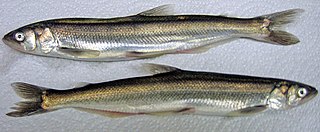 W
WThe eulachon, also called the candlefish, is a small anadromous ocean fish, a smelt found along the Pacific coast of North America from northern California to Alaska.
 W
WFreedom Village was a historic village founded by the former slaves of the Stó:lō, Chawathil First Nation who lived near present-day Hope, British Columbia.
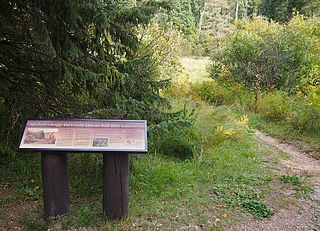 W
WThe game drive system is a hunting strategy in which game are herded into confined or dangerous places where they can be more easily killed. It can also be used for animal capture as well as for hunting, such as for capturing mustangs. The use of the strategy dates back into prehistory. Once a site is identified or manipulated to be used as a game drive site, it may be repeatedly used over many years.
 W
WTraditional gender roles among Native American and First Nations peoples tend to vary greatly by region and community. As with all Pre-Columbian era societies, historical traditions may or may not reflect contemporary attitudes. In many communities, these things are not discussed with outsiders.
 W
WThe Great Spirit is the concept of a life force, a Supreme Being or god known more specifically as Wakan Tanka in Lakota, Gitche Manitou in Algonquian, and by other, specific names in a number Native American and First Nations cultures. While the concept is common to a number of indigenous cultures in the United States and Canada, it is not shared by all cultures, or necessarily interpreted in the same way. According to Lakota activist Russell Means, a more semantically accurate translation of Wakan Tanka is the Great Mystery.
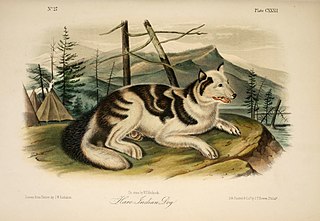 W
WThe Hare Indian dog is an extinct domesticated canine; possibly a breed of domestic dog, coydog, or domesticated coyote; formerly found and originally bred in northern Canada by the Hare Indians for coursing. It had the speed and some characteristics of the coyote, but the domesticated temperament and other characteristics of a domestic dog. It gradually lost its usefulness as aboriginal hunting methods declined, and became extinct or lost its separate identity through interbreeding with dogs in the 19th century, though some claim the breed still exists in modified form.
 W
WA house dish is a very large wooden dish, often ornately carved and painted in various human or animal figures, used in First Nations ceremonies in British Columbia. House dishes may be reserved only for special foodstuffs and not used for more common fare.
 W
WThe Indians of Canada Pavilion was a pavilion at the 1967 International and Universal Exposition in Montreal, Quebec, Canada.
 W
WKwakwaka'wakw art describes the art of the Kwakwaka'wakw peoples of British Columbia. It encompasses a wide variety of woodcarving, sculpture, painting, weaving and dance. Kwakwaka'wakw arts are exemplified in totem poles, masks, wooden carvings, jewelry and woven blankets. Visual arts are defined by simplicity, realism, and artistic emphasis. Dances are observed in the many rituals and ceremonies in Kwakwaka'wakw culture. Much of what is known about Kwakwaka'wakw art comes from oral history, archeological finds in the 19th century, inherited objects, and devoted artists educated in Kwakwaka'wakw traditions.
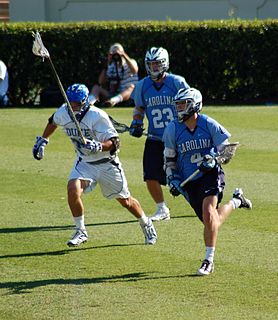 W
WLacrosse is a team sport played with a lacrosse stick and a lacrosse ball. It is the oldest organized sport in North America, with its origins in a tribal game played by the indigenous peoples of the Eastern Woodlands and by various other indigenous peoples of North America. The game was extensively modified reducing the violence by European colonizers to create its current collegiate and professional form.
 W
WManitou, akin to the Iroquois orenda, is the spiritual and fundamental life force among Algonquian groups in the Native American theology. It is omnipresent and manifests everywhere: organisms, the environment, events, etc. Aashaa monetoo means "good spirit", while otshee monetoo means "bad spirit". When the world was created, the Great Spirit, Aasha Monetoo, gave the land to the indigenous peoples, the Shawnee in particular.
 W
WA moccasin is a shoe, made of deerskin or other soft leather, consisting of a sole and sides made of one piece of leather, stitched together at the top, and sometimes with a vamp. The sole is soft and flexible and the upper part often is adorned with embroidery or beading. Though sometimes worn inside, it is chiefly intended for outdoor use. Historically, it is the footwear of many indigenous people of North America; moreover, hunters, traders, and European settlers wore them. Etymologically, the moccasin derives from the Algonquian language Powhatan word makasin, and from the Proto-Algonquian word *maxkeseni (shoe).
 W
WNative American cuisine includes all cuisines and food practices of the indigenous peoples of the Americas. Contemporary Native peoples retain a varied culture of traditional foods, along with the addition of some post-contact foods that have become customary and even iconic of present-day Native American social gatherings. Foods like cornbread, turkey, cranberry, blueberry, hominy and mush have been adopted into the cuisine of the broader United States population from Native American cultures.
 W
WA potlatch is a gift-giving feast practiced by Indigenous peoples of the Pacific Northwest Coast of Canada and the United States, among whom it is traditionally the primary governmental institution, legislative body, and economic system. This includes the Heiltsuk, Haida, Nuxalk, Tlingit, Makah, Tsimshian, Nuu-chah-nulth, Kwakwaka'wakw, and Coast Salish cultures. Potlatches are also a common feature of the peoples of the Interior and of the Subarctic adjoining the Northwest Coast, although mostly without the elaborate ritual and gift-giving economy of the coastal peoples.
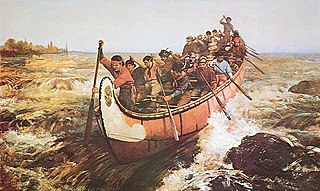 W
WA rabaska or Maître canoe was originally a large canoe made of tree bark, used by the Algonquin people.
 W
WThe Raven and the First Men is a sculpture by Haida artist Bill Reid. It depicts the Haida creation myth. It was carved from a single block of laminated yellow cedar, beginning in the fall of 1978, and took two years to complete, with work completing on April 1, 1980. Raven and the First Men is depicted on the reverse of the former Canadian twenty dollar bill of the Canadian Journey series.
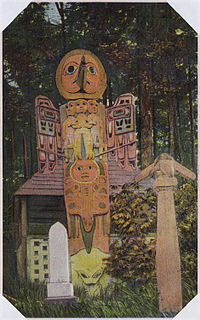 W
WRaven Tales are the traditional human and animal creation stories of the indigenous peoples of the Pacific Northwest Coast. They are also found among Athabaskan-speaking peoples and others. Raven stories exist in nearly all of the First Nations throughout the region but are most prominent in the tales of the Tlingit and Tahltan people.
 W
WA decrepit car is a car that is often old and damaged and is in a barely functional state. Numerous slang terms are used to describe such cars, which vary by country and region, including beater, clunker, jalopy and banger.
 W
WPorcupine hair roaches are a traditional male headdress of a number of Native American tribes in what is now New England, the Great Lakes and Missouri River regions, including the Potawatomi who lived where Chicago now stands. They were and still are most often worn by dancers at pow wows as regalia.
 W
WSlahal is a gambling game of the indigenous peoples of the Pacific Northwest Coast, also known as stickgame, bonegame, bloodless war game, handgame, or a name specific to each language. It is played throughout the western United States and Canada by indigenous peoples. Traditionally, the game uses the shin bones from the foreleg of a deer or other animal. The name of the game is a Chinook Jargon word.
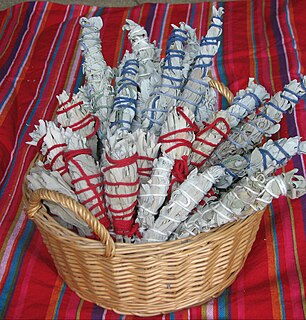 W
WSmudging, or other rites involving the burning of sacred herbs or resins, is a ceremony practiced by some Indigenous peoples of the Americas. While it bears some resemblance to other ceremonies and rituals involving smoke from other world cultures, notably those for spiritual cleansing or blessing, the purposes and particulars of the ceremonies, and the substances used, can vary widely between tribes, bands and nations, and even more so between different world cultures. In traditional communities, Elders maintain the protocols around these ceremonies and provide culturally specific guidance. The smudging ceremony, by various names, has been appropriated by others outside of the Indigenous communities as part of New Age or commercial practices.
 W
WA Soulcatcher or soul catcher is an amulet (Aatxasxw) used by the shaman (Halayt) of the Pacific Northwest Coast of British Columbia and Alaska. It is believed by Tsimshian that all soulcatchers were constructed by the Tsimshian tribe, and traded to the other tribes.
 W
WThe Spirit of Haida Gwaii is a sculpture by British Columbia Haida artist Bill Reid (1920–1998). There are two versions of it: the black canoe and the jade canoe. The black canoe features on Canadian $20 bills issued between 2004 and 2012.
 W
WThe Sun Dance is a ceremony practiced by some Native Americans and Aboriginal Canadians, primarily those of the Plains cultures. It usually involves the community gathering together to pray for healing. Individuals make personal sacrifices on behalf of the community.
 W
WThe Tahltan Bear Dog was a breed of dog indigenous to Canada.
 W
WThe thunderbird is a legendary creature in certain North American indigenous peoples' history and culture. It is considered a supernatural being of power and strength.
 W
WThunderbird Park is a park in Victoria, British Columbia next to the Royal British Columbia Museum. The park is home to many totem poles and other First Nation monuments. The park takes its name from the mythological Thunderbird of Indigenous North American cultures which is depicted on many totem poles.
 W
WA tumpline is a strap attached at both ends to a sack, backpack, or other luggage and used to carry the object by placing the strap over the top of the head. This utilizes the spine rather than the shoulders as standard backpack straps do. Tumplines are not intended to be worn over the forehead, but rather over the top of the head just back from the hairline, pulling straight down in alignment with the spine. The bearer then leans forward, allowing the back to help support the load.
 W
WThe Unistʼotʼen Camp is a camp built on the territory of the Unist'otʼen clan of the Wetʼsuwetʼen First Nation peoples in northern British Columbia, Canada. It is located at the point where several planned energy pipelines will pass, as a means to block the crossing of Wetʼsuwetʼen territory by pipeline-related industries.
 W
WViburnum trilobum is a species of Viburnum native to northern North America, from Newfoundland west to British Columbia, south to Washington state and east to northern Virginia. It is very closely related to the European and Asian Viburnum opulus, and is often treated as a variety of it, as Viburnum opulus L. var. americanum Ait., or as a subspecies, Viburnum opulus subsp. trilobum (Marshall) Clausen.
 W
WWampum is a traditional shell bead of the Eastern Woodlands tribes of Native Americans. It includes white shell beads hand fashioned from the North Atlantic channeled whelk shell and white and purple beads made from the quahog or Western North Atlantic hard-shelled clam. Before European contact, strings of wampum were used for storytelling, ceremonial gifts, and recording important treaties and historical events, such as the Two Row Wampum Treaty or The Hiawatha Belt. Wampum was also used by the northeastern Indian tribes as a means of exchange, strung together in lengths for convenience. The first Colonists adopted it as a currency in trading with them. Eventually, the Colonists applied their technologies to more efficiently produce wampum, which caused inflation and ultimately its obsolescence as currency.
 W
WWar bonnets are feathered headgear traditionally worn by male leaders of the American Plains Indians Nations who have earned a place of great respect in their tribe. Originally they were sometimes worn into battle, but they are now primarily used for ceremonial occasions. In the Native American and First Nations communities that traditionally have these items of regalia, they are seen as items of great spiritual and political importance, only to be worn by those who have earned the right and honour through formal recognition by their people.
 W
WA war canoe is a watercraft of the canoe type designed and outfitted for warfare, and which is found in various forms in many world cultures. In modern times, such designs have become adapted as a sport, and "war canoe" can mean a type of flatwater racing canoe.
 W
WX̲áːytem is an indigenous archaeological site and the name of a related museum run under the auspices of the Stoːlo people at Hatzic, British Columbia, Canada. X̲áːytem is approximately 80 kilometres east of Vancouver on Highway 7. It is reached via the bridge at Mission, about 15 kilometres from the border with the US state of Washington. The site was designated in 1992 as a national historic site of Canada, for its spiritual value to the Stoːlo people, as well as being one of the oldest discovered habitation sites at approximately 5000 years old. It is also known as Hatzic Rock.